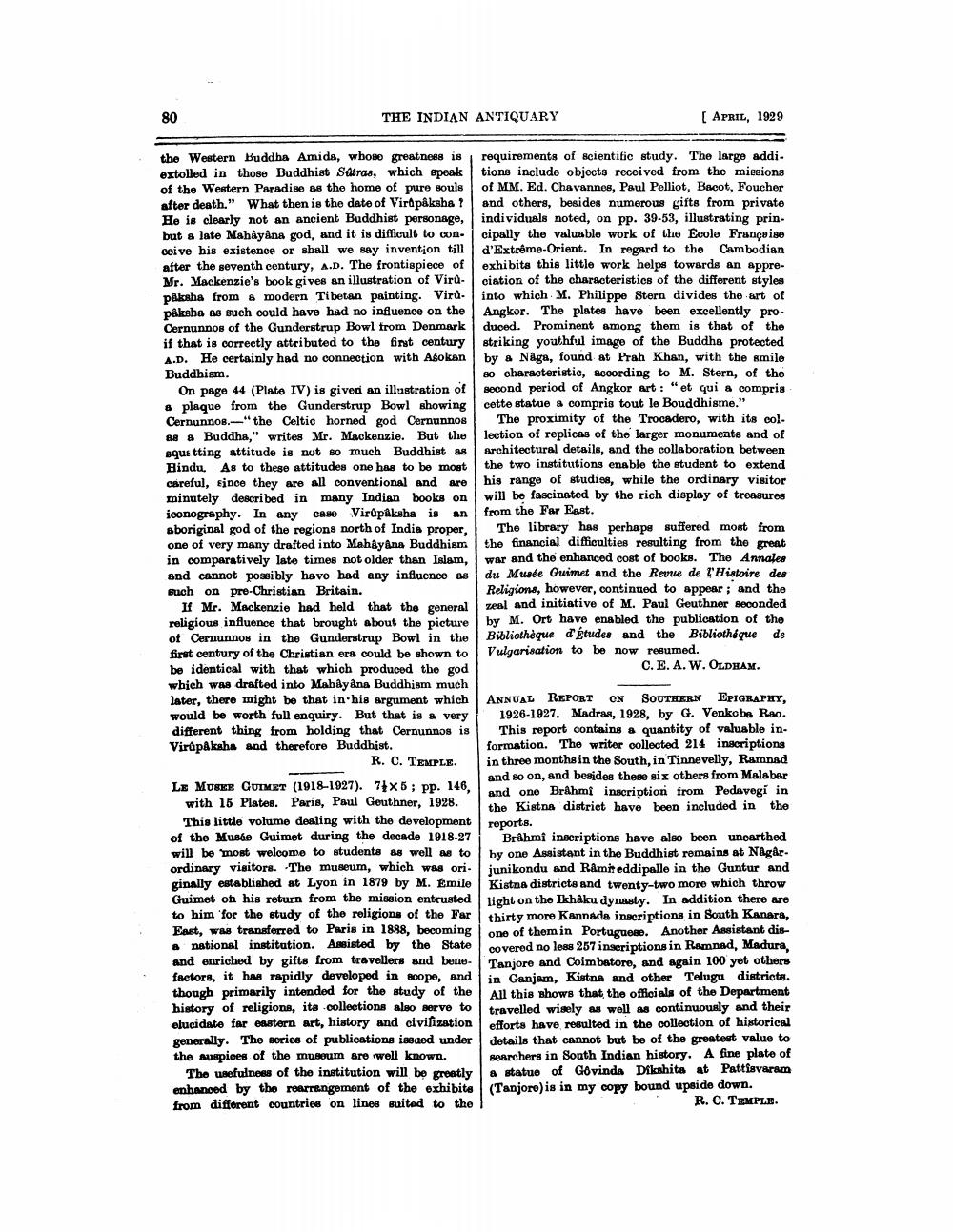________________
THE INDIAN ANTIQUARY
APRIL, 1929
the Western Buddha Amida, wboso greatness is requirements of scientific study. The large addi. extolled in those Buddhist Sutras, which speak tions include objects received from the missions of the Western Paradise as the home of pure souls of MM. Ed. Chavannes, Paul Pelliot, Bacot, Foucher after death." What then is the date of Vird påksha ? and others, besides numerous gifts from private He is clearly not an ancient Buddhist personage, individuals noted, on pp. 39-53, illustrating prinbut a late Mabîyana god, and it is difficult to con. cipally the valuable work of the Ecole Française ceive his existence or shall we say invention till d'Extrême-Orient. In regard to the Cambodian after the seventh century, A.D. The frontispiece of exhibits this little work helps towards an appreMr. Mackenzie's book gives an illustration of Viru- ciation of the characteristics of the different styles PAksha from a modern Tibetan painting. Viru- into which M. Philippe Stern divides the art of paksha as such could have had no influence on the Angkor. The plates have been excellently proCernunnos of the Gunderstrup Bowl from Denmark duced. Prominent among them is that of the if that is correctly attributed to the first century striking youthful image of the Buddha protected A.D. He certainly had no connection with Asokan by a Någa, found at Prah Khan, with the smile Buddhism.
80 characteristic, according to M. Stern, of the On page 44 (Plato IV) is given an illustration of second period of Angkor art: "et qui a compris & plaque from the Gunderstrup Bowl showing cette statue a compris tout le Bouddhisme." Cernunnos.--"the Celtic horned god Cernunnos I The proximity of the Trocadero, with its col. as a Buddha," writes Mr. Mackenzie. But the lection of replicas of the larger monuments and of Bquetting attitude is not so much Buddhist as architectural details, and the collaboration between Hindu. As to these attitudes one has to be most the two institutions enable the student to extend careful, since they are all conventional and are
his range of studiss, while the ordinary visitor minutely described in many Indian books on will be fascinated by the rich display of trossures iconography. In any case VirupAksha is an from the Far East. aboriginal god of the regions north of India proper, The library has perhape suffered most from one of very many drafted into Mahayana Buddhism. the financial difficulties resulting from the great in comparatively late times not older than Islam, war and the enhanced cost of books. The Annales and cannot possibly have had any influence as du Muade Guimet and the Revue de l'Histoire des euch on pre-Christian Britain.
Religions, however, continued to appear; and the If Mr. Mackenzie had held that the general zeal and initiative of M. Paul Geuthner seconded religious influence that brought about the picture by M. Ort have enabled the publication of the of Cernunnos in the Gunderstrup Bowl in the
Bibliothèque d'Études and the Bibliotheque de first century of the Christian ers could be shown to Vulgarisation to be now resumed. be identical with that which produced the god
C.E.A.W.OLDHAM. which was drafted into Mahayana Buddhism much later, there might be that in his argument which ANNUAL REPORT ON SOUTHERN EPIGRAPHY, would be worth full enquiry. But that is a very 1926-1927. Madras, 1928, by G. Venkoba Rao. different thing from holding that Cernunnos is This report contains a quantity of valuable in. VirūpAksha and therefore Buddhist.
formation. The writer collected 214 inscriptions R. C. TEMPLE. in three months in the South, in Tinnevelly, Ramnad
and so on, and boaides these six others from Malabar LE MUKEE GUIMET (1918-1927). 71x5; pp. 146,
and one Brahmi inscription from Pedavegi in with 15 Plates. Paris, Paul Geuthner, 1928.
the Kistna district have been included in the This little volume dealing with the development reports. of the Musée Guimet during the decade 1918-27 Brahmi inscriptions have also been unearthed will be most welcome to students as well as to by one Assistant in the Buddhist remains at Nagarordinary visitors. The museum, which was orijunikondu and Ramint eddipallo in the Guntur and ginally established at Lyon in 1879 by M. Emile Kistna districts and twenty-two more which throw Guimet on his return from the mission entrusted light on the IkhAku dynasty. In addition there are to him for the study of the religions of the Far thirty more Kannada inscriptions in South Kanars, East, was transferred to Paris in 1888, becoming one of them in Portuguese. Another Assistant dis& national institution. Assisted by the State
covered no less 257 inscriptions in Ramnad, Madura and enriched by gifts from travellers and bene. Tanjore and Coimbatore, and again 100 yet others factors, it has rapidly developed in scope, and in Ganjam, Kistna and other Telugu districts. though primarily intended for the study of the All this shows that the officials of the Department history of religions, its collections also serve to
LIONS also serve to travelled wisely as well as continuously and their elucidato far eastern art, history and civilization efforts have resulted in the collection of historical generally. The series of publications issued under details that cannot but be of the greatest value to the auspioes of the museum are well known. searchers in South Indian history. A fine plate of
The usefulness of the institution will be greatly & statue of Govinda Dikshita at Pattiavaram enhanced by the roarrangement of the exhibitel (Tanjoro) is in my copy bound upside down. from different countries on lines suited to the
R. C. TEMPLE




